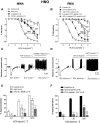A role for nitroxyl (HNO) as an endothelium-derived relaxing and hyperpolarizing factor in resistance arteries
- PMID: 19338582
- PMCID: PMC2707966
- DOI: 10.1111/j.1476-5381.2009.00150.x
A role for nitroxyl (HNO) as an endothelium-derived relaxing and hyperpolarizing factor in resistance arteries
Abstract
Background and purpose: Nitroxyl (HNO) is emerging as an important regulator of vascular tone as it is potentially produced endogenously and dilates conduit and resistance arteries. This study investigates the contribution of endogenous HNO to endothelium-dependent relaxation and hyperpolarization in resistance arteries.
Experimental approach: Rat and mouse mesenteric arteries were mounted in small vessel myographs for isometric force and smooth muscle membrane potential recording.
Key results: Vasorelaxation to the HNO donor, Angeli's salt, was attenuated in both species by the soluble guanylate cyclase inhibitor (ODQ, 1H-[1,2,4]oxadiazolo[4,3-a]quinoxaline-1-one), the voltage-dependent K(+) channel inhibitor, 4-aminopyridine (4-AP) and the HNO scavenger, L-cysteine. In mouse mesenteric arteries, nitric oxide (NO) synthase inhibition (with L-NAME, N(omega)-Nitro-L-arginine methyl ester) markedly attenuated acetylcholine (ACh)-mediated relaxation. Scavenging the uncharged form of NO (NO(*)) with hydroxocobalamin (HXC) or HNO with L-cysteine, or 4-AP decreased the sensitivity to ACh, and a combination of HXC and L-cysteine reduced ACh-mediated relaxation, as did L-NAME alone. ACh-induced hyperpolarizations were significantly attenuated by 4-AP alone and in combination with L-NAME. In rat mesenteric arteries, blocking the effects of endothelium-derived hyperpolarizing factor (EDHF) (charybdotoxin and apamin) decreased ACh-mediated relaxation 10-fold and unmasked a NO-dependent component, mediated equally by HNO and NO(*), as HXC and L-cysteine in combination now abolished vasorelaxation to ACh. Furthermore, ACh-evoked hyperpolarizations, resistant to EDHF inhibition, were virtually abolished by 4-AP.
Conclusions and implications: The factors contributing to vasorelaxation in mouse and rat mesenteric arteries are NO(*) = HNO > EDHF and EDHF > HNO = NO(*) respectively. This study identified HNO as an endothelium-derived relaxing and hyperpolarizing factor in resistance vessels.
Figures




Comment in
-
Nitroxyl anion--the universal signalling partner of endogenously produced nitric oxide?Br J Pharmacol. 2009 Jun;157(4):537-9. doi: 10.1111/j.1476-5381.2009.00153.x. Br J Pharmacol. 2009. PMID: 19630833 Free PMC article.
References
-
- Adak S, Wang Q, Stuehr DJ. Arginine conversion of nitroxide by tetrahydrobiopterin-free neuronal nitric-oxide synthase. J Biol Chem. 2000;275:33554–33561. - PubMed
-
- Arnelle DR, Stamler JS. NO+, NO•, NO− donation by S-nitrosothiols: implications for regulation of physiological functions by S-nitrosylation and acceleration of disulfide formation. Arch Biochem Biophys. 1995;318:279–285. - PubMed
-
- Brandes RP, Schmitz-Winnenthal FH, Feletou M, Godecke A, Huang PL, Vanhoutte PM, et al. An endothelium-derived hyperpolarizing factor distinct from NO and prostacyclin is a major endothelium-dependent vasodilator in resistance vessels of wild-type and endothelial NO synthase knockout mice. Proc Natl Acad Sci USA. 2000;97:9747–9752. - PMC - PubMed
Publication types
MeSH terms
Substances
LinkOut - more resources
Full Text Sources
Medical

